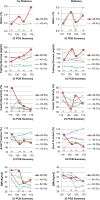Persistent organic pollutants in young adults and changes in glucose related metabolism over a 23-year follow-up
- PMID: 25706918
- PMCID: PMC4429782
- DOI: 10.1016/j.envres.2014.11.001
Persistent organic pollutants in young adults and changes in glucose related metabolism over a 23-year follow-up
Abstract
Objectives: Substantial evidence associates persistent organic pollutants (POP) with metabolic disturbances related to diabetes, but longitudinal studies with repeated measures are scarce. We aimed to characterize the association between background exposures to POPs with repeated measures of glucose homeostasis over 23-years.
Methods: Within the Coronary Artery Risk Development in Young Adults study (year 0 ages: 18-30 years), we measured POPs in serum obtained in 1987-88 (follow-up year 2) in 90 non-diabetic controls and 90 cases diabetes-free at year 2 who became diabetic by year 20. We analyzed 32 POPs detectable in ≥75% of participants and created summary scores for 32 POPs, 23 polychlorinated biphenyls (PCB), and 8 organochlorine pesticides (OCP). Dependent variables were measures of glucose homeostasis at years 0-25 (up to 8 examinations). We explored associations using repeated measures regression adjusted for race, sex, concurrent body mass index (BMI), examination center and period, separately for cases and controls.
Results: The associations between the three summary scores and measures of glucose homeostasis were present for observations at ages 40-55 years, and particularly between 48-55 years: the 23 PCB summary was associated with HbA1c (never-diabetics: slope [value per unit of summary score], β=0.008, p=0.02; diabetics: β=0.03, p=0.07), fasting glucose (never-diabetics: β=0.24, p=0.003; diabetics: β=1.10, p=0.03), and insulin sensitivity% (never-diabetics: β=-2.82, p<0.001, diabetics: β=-0.31, p=0.30). No associations were observed at younger ages.
Conclusions: Glucose homeostasis may worsen after decades of exposure to PCBs and OCPs at background environmental levels, independent of BMI and after participants reached the 5th decade of life.
Keywords: Glucose; HbA1c; Organochlorine; PCB; POPs.
Copyright © 2014 Elsevier Inc. All rights reserved.
Conflict of interest statement
None.
Figures

Similar articles
-
Low dose organochlorine pesticides and polychlorinated biphenyls predict obesity, dyslipidemia, and insulin resistance among people free of diabetes.PLoS One. 2011 Jan 26;6(1):e15977. doi: 10.1371/journal.pone.0015977. PLoS One. 2011. PMID: 21298090 Free PMC article.
-
Obesity and persistent organic pollutants: possible obesogenic effect of organochlorine pesticides and polychlorinated biphenyls.Obesity (Silver Spring). 2011 Apr;19(4):709-14. doi: 10.1038/oby.2010.133. Epub 2010 Jun 17. Obesity (Silver Spring). 2011. PMID: 20559302
-
Serum concentrations of persistent organic pollutants and the metabolic syndrome in Akwesasne Mohawks, a Native American community.Environ Pollut. 2020 May;260:114004. doi: 10.1016/j.envpol.2020.114004. Epub 2020 Jan 23. Environ Pollut. 2020. PMID: 32004963 Free PMC article.
-
Persistent Organic Pollutant-Mediated Insulin Resistance.Int J Environ Res Public Health. 2019 Feb 3;16(3):448. doi: 10.3390/ijerph16030448. Int J Environ Res Public Health. 2019. PMID: 30717446 Free PMC article. Review.
-
Persistent organic pollutants and β-cell toxicity: a comprehensive review.Am J Physiol Endocrinol Metab. 2022 May 1;322(5):E383-E413. doi: 10.1152/ajpendo.00358.2021. Epub 2022 Feb 14. Am J Physiol Endocrinol Metab. 2022. PMID: 35156417 Free PMC article. Review.
Cited by
-
Lactation history, serum concentrations of persistent organic pollutants, and maternal risk of diabetes.Environ Res. 2016 Oct;150:282-288. doi: 10.1016/j.envres.2016.06.023. Epub 2016 Jun 20. Environ Res. 2016. PMID: 27336232 Free PMC article.
-
Summary data of serum concentrations of 32 persistent organic pollutants in young adults in relation to summary scores of persistent organic pollutants.Data Brief. 2019 Mar 7;23:103720. doi: 10.1016/j.dib.2019.103720. eCollection 2019 Apr. Data Brief. 2019. PMID: 31193752 Free PMC article.
-
Metabolism disrupting chemicals and metabolic disorders.Reprod Toxicol. 2017 Mar;68:3-33. doi: 10.1016/j.reprotox.2016.10.001. Epub 2016 Oct 17. Reprod Toxicol. 2017. PMID: 27760374 Free PMC article. Review.
-
Long-term in vivo polychlorinated biphenyl 126 exposure induces oxidative stress and alters proteomic profile on islets of Langerhans.Sci Rep. 2016 Jun 13;6:27882. doi: 10.1038/srep27882. Sci Rep. 2016. PMID: 27292372 Free PMC article.
-
Environmental neglect: endocrine disruptors as underappreciated but potentially modifiable diabetes risk factors.Diabetologia. 2019 Oct;62(10):1811-1822. doi: 10.1007/s00125-019-4940-z. Epub 2019 Aug 27. Diabetologia. 2019. PMID: 31451869 Free PMC article. Review.
References
-
- Airaksinen R, Rantakokko P, Eriksson JG, Blomstedt P, Kajantie E, Kiviranta H. Association between type 2 diabetes and exposure to persistent organic pollutants. Diabetes Care. 2011;34:1972–1979. http://dx.doi.org/10.2337/dc10-2303. - DOI - PMC - PubMed
-
- Barr JR, Maggio VL, Barr DB, Turner WE, Sjödin A, Sandau CD, et al. New high-resolution mass spectrometric approach for the measurement of polychlorinated biphenyls and organochlorine pesticides in human serum. J Chromatogr B: Analyt Technol Biomed Life Sci. 2003;794:137–148. - PubMed
-
- Bertazzi PA, Consonni D, Bachetti S, Rubagotti M, Baccarelli A, Zocchetti C, et al. Health effects of dioxin exposure: a 20-year mortality study. Am J Epidemiol. 2001;153:1031–1044. - PubMed
-
- Camhi SM, Bray GA, Bouchard C, Greenway FL, Johnson WD, Newton RL, et al. The relationship of waist circumference and BMI to visceral, subcutaneous, and total body fat: sex and race differences. Obesity (Silver Spring) 2011;19:402–408. http://dx.doi.org/10.1038/oby.2010.248. - DOI - PMC - PubMed
-
- Centers for Disease Control and Prevention. Environ Heal NCEH Pub. Atlanta, GA: 2009. Fourth National Report on Human Exposure to Environmental Chemicals; p. 529.
Publication types
MeSH terms
Substances
Grants and funding
- HHSN268201300026C/HL/NHLBI NIH HHS/United States
- R01HL53560/HL/NHLBI NIH HHS/United States
- R01 HL053560/HL/NHLBI NIH HHS/United States
- AG0005/AG/NIA NIH HHS/United States
- HHSN268201300025C/HL/NHLBI NIH HHS/United States
- ImNIH/Intramural NIH HHS/United States
- HHSN268201300029C/HL/NHLBI NIH HHS/United States
- T32HL007779/HL/NHLBI NIH HHS/United States
- HHSN268201300027C/HL/NHLBI NIH HHS/United States
- T32 HL007779/HL/NHLBI NIH HHS/United States
- HHSN268200900041C/HL/NHLBI NIH HHS/United States
- HHSN268201300028C/HL/NHLBI NIH HHS/United States
LinkOut - more resources
Full Text Sources
Other Literature Sources
Medical

